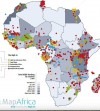For some experts, the current disruptions in African economies are, beyond questions of governance, a reflection of the inability of the United States to assume its responsibilities in the face of the consequences of the dynamics around its currency, the dollar.
The cost of the US dollar represents the highest risk for African businesses in 2023, according to analysts at South Africa-based rating agency GCR Ratings, whose majority shareholder is Moody’s Ratings Corporation.
“We can continue to talk about inflation or the raising of interest rates by central banks, but the main problem remains that of the cost of the dollar”, said one of the experts, within the framework of a podcast listened to by the Ecofin Agency.
He takes as an example the case of Ghanaian banks which, during a certain period, generated margins by carrying out transactions between the cedi (Ghanaian currency) and the dollar. He believes that the current volatility in the cost of the US currency is likely to put the profitability of these financial companies under pressure.
This approach to macroeconomic issues in Africa makes it possible to approach the economic challenges prevailing in African countries from another angle. In order to contain inflation, African central banks have mostly increased their key rates, with a view to slowing outstanding credit to the economy, reducing the money supply and bringing down prices.
Depending on the country or sub-region, these decisions had mixed impacts, as outstanding loans continued to grow. Also, taking into account the risks, the banks have concentrated their loans on the most profitable economic sectors. In West Africa, for example, (short-term) cash loans continue to dominate a market where large companies and governments obtain the bulk of the loans, to the detriment of sectors such as agriculture, whose low productivity drives inflation up.
We also find such a configuration in countries such as Ghana, Nigeria, Egypt and Kenya. The strictly monetary vision of inflation does not seem to be the appropriate basic assumption for managing the high cost of living and the risks this poses for the quality of debt in African countries. Being subject to the US dollar for imports of goods and especially services that dominate African consumption is a challenge that should be overcome with monetary and credit policies focused on the agricultural and informal sectors, which support most jobs in the region.
However, this threat represented today by the cost of the US dollar is not about to recede. “It will take a lot more evidence to be certain that inflation is on a sustainable downward path,” recently explained Jerome Powell, Chairman of the United States Federal Reserve, pointing out that high policy rates, and therefore a increasingly expensive dollar, will remain in place in 2023 and 2024.
At the same time, the International Monetary Fund (IMF), which is the policeman of the international financial system, recognizes the problem that the rise in the American currency represents for emerging and developing economies. But the solutions proposed by the institution are difficult to implement by the countries that are victims of the situation.
“Countries need to preserve their vital foreign exchange reserves to deal with potentially more severe outflows and turbulence in the future. Countries with sound economic policies that need to address moderate vulnerabilities should proactively use IMF precautions to meet their future liquidity needs.
For countries deemed to be heavily indebted in foreign currencies, including those in sub-Saharan Africa, it is recommended to “reduce exchange rate mismatches through the use of capital flow management or macroprudential policies, in addition to debt management operations”. debt to smooth repayment profiles”. Solutions that are difficult to understand and complex to manage.
At the same time, international rating agencies apply rigorous measures to assess the situation without qualms. Most of the countries in the region have their sovereign ratings downgraded, which further increases their difficulties in refinancing their existing debts, and makes access to external financing more costly for their businesses, both financial and non-financial.





























Réagissez à cet article